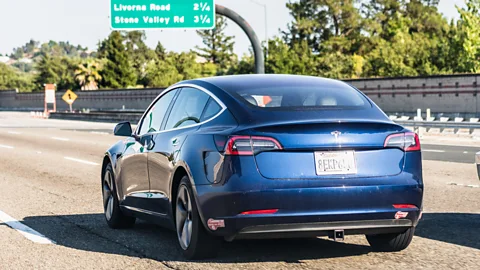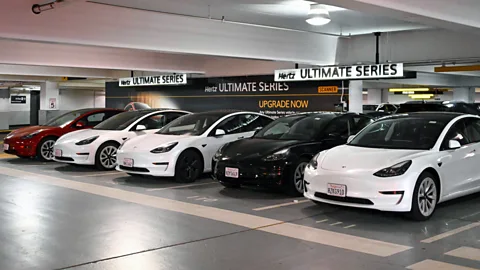By Martine Paris
 Alamy
AlamyFor the first time, consumers will have a vast pool of used EVs available for purchase. Will hesitant drivers buy them?
Twenty-thousand Teslas are about to flood the US used-car market, as rental-car giant Hertz seeks to shed a third of its electric vehicle fleet.
For drivers, it's a chance to snag a Tesla for well below market rate. The Hertz Car Sales website shows more than 200 used Teslas selling for less than $25,000 (£19,800), as of this writing. In comparison, a new Tesla Model 3 – the company's least-expensive offering – starts at $35,990 (£28,500). These prices are even lower than the US's cheapest new EV, a Nissan Leaf, which sells for around $29,000 (£22,965).
As Hertz sheds its stock, experts also expect more used electric vehicles will hit the market from dealerships, other rental fleets and private owners, particularly as three-year leases expire. For consumers who have been EV-curious, the new global secondary market presents a prime opportunity to purchase one at a steep discount – especially at a time when automakers continue to struggle with bringing down prices on new models.
"From next year onwards, there will be very significant volumes [of used EVs], and we can expect prices to go down significantly," says Thibaud Simphal, Global Head of Sustainability for Uber.
If the price is right, even consumers who don't have first-hand experience with EVs might decide to jump in, says Felipe Smolka, a partner at EY and leader of the firm's mobility practice. Indeed, this unprecedented influx of discounted cars could mark an inflection point for EV sales – particularly in the US, where many Americans cite price as one of the major barriers to mass adoption. A record number of used electric vehicles are expected to sell in 2024, according to Recurrent, a vehicle-data research firm, which produces a quarterly Used Car Prices and Market Report.
 Alamy
AlamySome people have been waiting for this secondary market, and will be quick to buy these vehicles, say experts. And, as the first wave of consumers take the plunge, there could be a knock-on effect in which hesitant adopters may find the perceptions holding them back – repair costs, battery life and charging access – dispelled by satisfied drivers.
One segment that has already experienced take-up of used EVs, even among a limited pool of stock, are rideshare drivers, says Thibauld. Since 2021, Uber has partnered with Hertz and other rental agencies in multiple countries to incentivise their drivers to adopt EVs with credits and steeply-discounted weekly rental rates. In 2022, the company reported 92% of the drivers renting a Tesla in the US through Hertz said they were considering purchasing an EV.
Due in part to these initiatives, the number of EVs on the Uber ride-hailing network has doubled in the past year, says Simphal. There are now more than 126,000 monthly active EV drivers on the Uber platform, which currently makes it the biggest network for electric vehicles, according to the company.
Now that more professional and private drivers will have the opportunity to purchase a used EV amid a growing market, and more electric vehicles hit the road, consumers will increasingly learn about the realities and expenses of owning an EV. Beyond anecdotal accounts, more hard data will become available.
Amid Uber's programme with Hertz, for instance, the company collected information on where chargers were – and were not – available, based on rideshare drivers' trips in England and France. They also documented the mileage range of the Teslas after charging. Uber shared this data with governments and private companies to help improve infrastructure planning as well address consumer misconceptions.
EY's Smolka says this education is key for EV adoption, especially as consumers also express concerns about charger availability, mileage range and maintenance costs, particularly with used EVs.
For example, people might hesitate to buy a pre-owned Tesla Model 3 with 88,000 miles (141,622km) of wear, because the warranty on the battery is 100,000 miles (160,934km). This is a worry, because after-market EV batteries can cost upwards of $20,000 (£15,835). But in 2021, Tesla reported that its batteries last roughly 200,000 miles (321,868km) in the US and 150,000 (241,402km) miles in Europe. Even after 200,000 miles, it says its batteries degrade only 12%.
The more consumers understand data around used EVs like this, says Smolka, the more confident they will become that they won't necessarily have to invest in prohibitively expensive maintenance shortly after they buy a vehicle. He also believes the price of replacement parts will likely come down as the aftermarket grows and matures, and circularity improves.
As the used EV market emerges, proponents are hopeful the first adopters will serve as pioneers who can teach hesitant consumers that a pre-owned electric vehicle is a worthwhile investment – and a really good deal.
"used" - Google News
February 23, 2024 at 01:00PM
https://ift.tt/YvnASQI
The used electric vehicle market could tempt EV-curious drivers - BBC.com
"used" - Google News
https://ift.tt/yQe2WsE
https://ift.tt/mdsPqcS
Bagikan Berita Ini














0 Response to "The used electric vehicle market could tempt EV-curious drivers - BBC.com"
Post a Comment